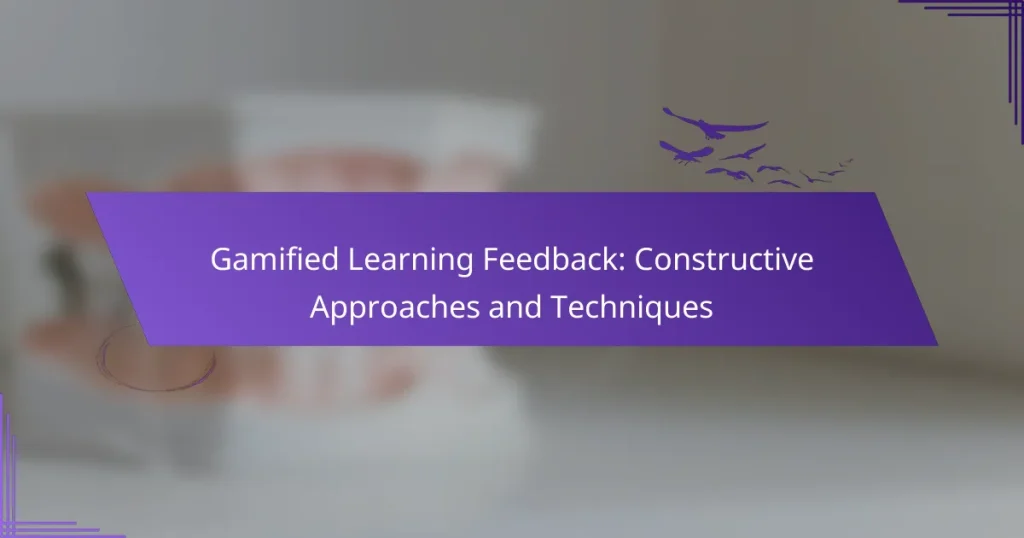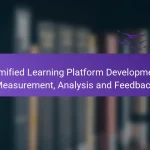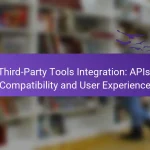Gamified learning feedback transforms the educational experience by integrating game-like elements that boost student engagement and provide immediate performance insights. By utilizing techniques such as rewards, peer reviews, and progress tracking, this approach ensures that learners receive constructive and actionable feedback while enjoying the learning process.
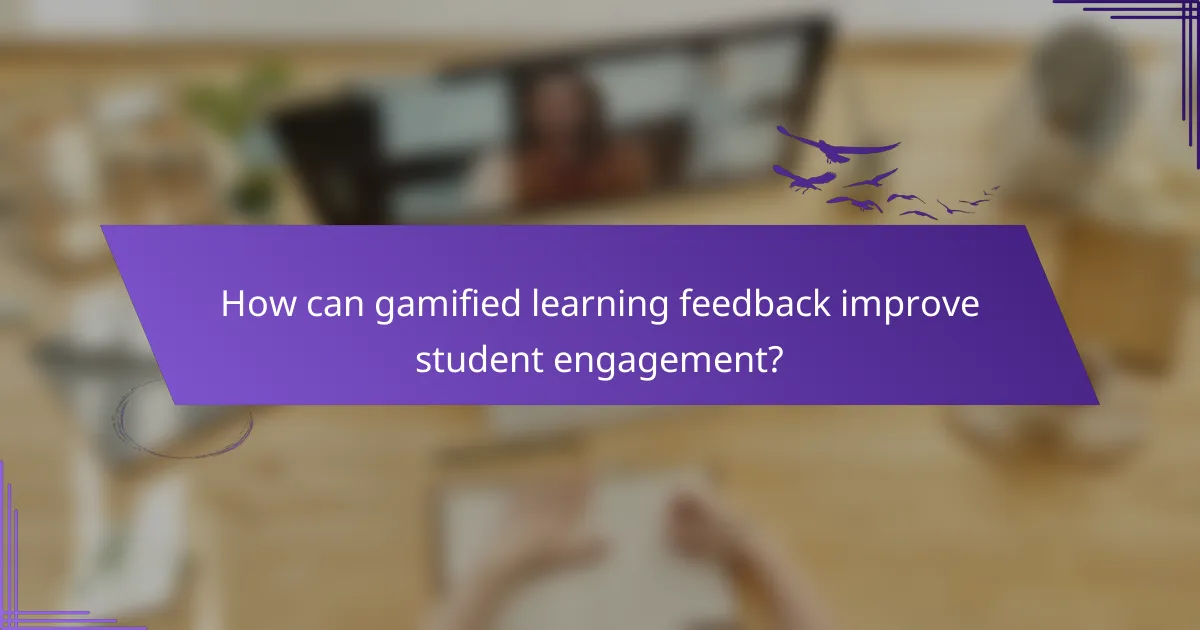
How can gamified learning feedback improve student engagement?
Gamified learning feedback enhances student engagement by incorporating game-like elements that motivate learners and provide immediate insights into their performance. This approach transforms traditional feedback into an interactive experience, making learning more enjoyable and effective.
Increased motivation through rewards
Gamified learning often includes rewards such as points, badges, or leaderboards, which can significantly boost student motivation. These incentives encourage learners to complete tasks and engage with the material, fostering a sense of achievement and competition.
To effectively implement rewards, consider setting achievable milestones that students can reach. For example, offering small rewards for completing lessons can maintain interest and drive progress. However, ensure that the rewards are meaningful and relevant to the learning objectives.
Enhanced retention via interactive elements
Interactive elements, such as quizzes, simulations, and challenges, help reinforce learning by actively involving students in the process. This hands-on approach promotes deeper understanding and retention of the material compared to passive learning methods.
Incorporating varied interactive activities can cater to different learning styles. For instance, visual learners may benefit from simulations, while kinesthetic learners might excel with hands-on challenges. Balancing these elements can create a more inclusive learning environment.
Real-time feedback for immediate improvement
Real-time feedback allows students to receive instant insights into their performance, enabling them to identify areas for improvement quickly. This immediate response fosters a growth mindset, encouraging learners to adjust their strategies and enhance their skills on the spot.
To maximize the effectiveness of real-time feedback, use tools that provide instant assessments after quizzes or activities. Additionally, consider incorporating peer feedback mechanisms where students can learn from each other’s experiences, further enriching the learning process.
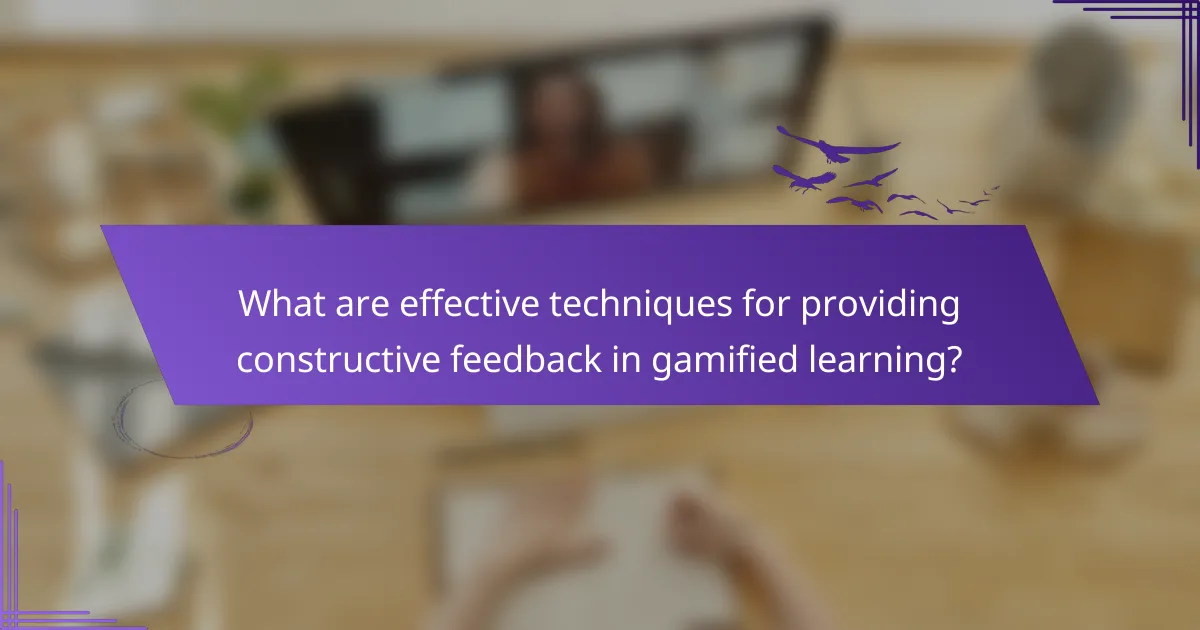
What are effective techniques for providing constructive feedback in gamified learning?
Effective techniques for providing constructive feedback in gamified learning include using rewards like badges, incorporating peer reviews, and utilizing progress tracking tools. These methods enhance engagement and motivation while ensuring learners receive actionable insights to improve their performance.
Use of badges and achievements
Badges and achievements serve as tangible rewards that recognize learners’ accomplishments in gamified environments. They can motivate learners by providing a sense of achievement and encouraging them to strive for higher goals.
To implement this technique, consider setting clear criteria for earning badges. For example, a learner might earn a badge for completing a module, achieving a high score, or demonstrating mastery of a skill. This clarity helps learners understand what is required to succeed.
Incorporation of peer reviews
Peer reviews allow learners to provide and receive feedback from their peers, fostering a collaborative learning environment. This technique encourages critical thinking and helps learners gain diverse perspectives on their work.
When incorporating peer reviews, establish guidelines to ensure constructive feedback. For instance, encourage learners to highlight strengths and suggest improvements. This approach not only enhances learning but also builds communication skills.
Utilization of progress tracking tools
Progress tracking tools help learners visualize their advancement and identify areas needing improvement. These tools can include dashboards that display completed tasks, scores, and areas of mastery.
To maximize the effectiveness of progress tracking, ensure that the tools are user-friendly and provide real-time updates. For example, a simple progress bar can motivate learners by showing how close they are to achieving their next goal. Regularly reviewing this data can guide learners in setting realistic targets and adjusting their study strategies accordingly.

What are the best platforms for gamified learning feedback?
The best platforms for gamified learning feedback include tools that enhance engagement through interactive elements, quizzes, and role-playing. These platforms not only provide feedback but also foster a fun learning environment that motivates users to improve.
Kahoot! for interactive quizzes
Kahoot! is a popular platform that allows educators to create interactive quizzes that students can participate in real-time. Users can join via a game PIN on their devices, making it easy to engage large groups.
Consider using Kahoot! for formative assessments or review sessions, as it provides instant feedback on answers. The platform’s game-like format can increase participation and retention, making learning enjoyable.
Moodle for course management
Moodle is a comprehensive learning management system (LMS) that supports gamified learning through customizable course structures and feedback mechanisms. Educators can incorporate quizzes, badges, and leaderboards to motivate learners.
When using Moodle, ensure you leverage its analytics tools to track student progress and feedback effectively. This data can help tailor the learning experience to meet individual needs, enhancing overall engagement.
Classcraft for role-playing elements
Classcraft combines learning with role-playing games, allowing students to assume characters and earn rewards based on their academic performance and behavior. This platform encourages collaboration and accountability among peers.
Utilize Classcraft to create a narrative around your curriculum, which can make lessons more relatable. Be mindful of balancing game mechanics with educational goals to maintain focus on learning outcomes while keeping students engaged.
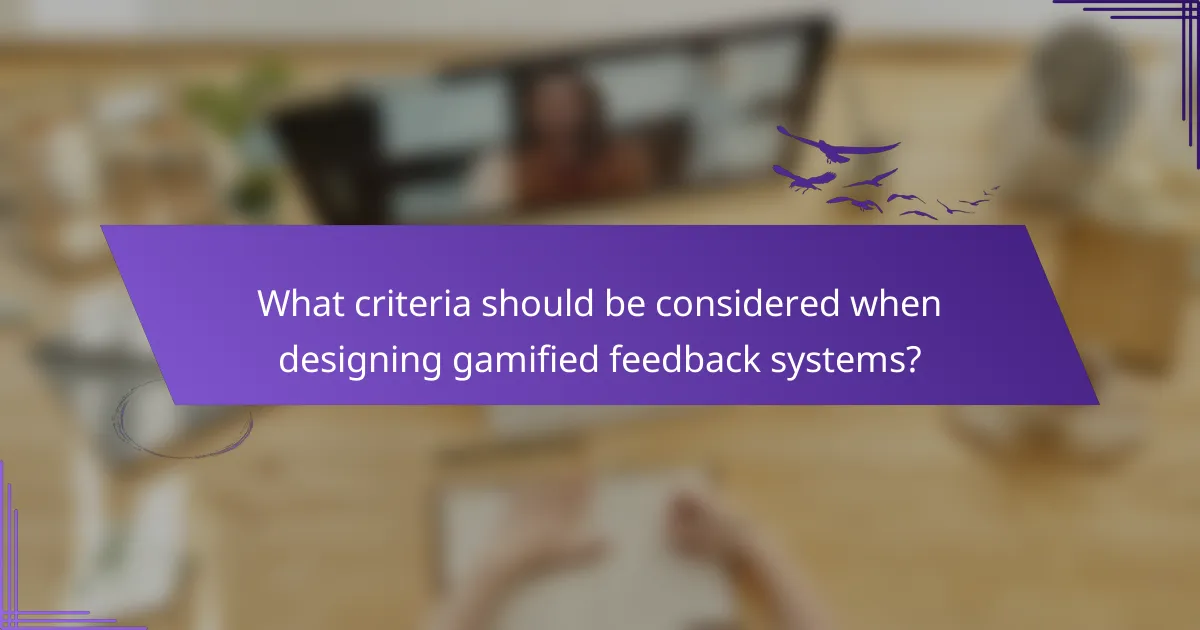
What criteria should be considered when designing gamified feedback systems?
When designing gamified feedback systems, it’s essential to consider alignment with learning objectives, scalability for different class sizes, and accessibility for diverse learners. These criteria ensure that the feedback is effective, inclusive, and adaptable to various educational environments.
Alignment with learning objectives
Gamified feedback should directly support the specific learning objectives of the course or program. This means that each feedback element must reinforce the skills or knowledge that learners are expected to acquire. For example, if a course aims to enhance critical thinking, feedback should challenge students to analyze and evaluate information critically.
To achieve this alignment, educators can map feedback mechanisms to learning goals. Using a checklist can help ensure that each feedback component serves a clear educational purpose, enhancing the overall learning experience.
Scalability for different class sizes
Scalability is crucial for gamified feedback systems, as classroom sizes can vary significantly. Feedback mechanisms should be designed to function effectively whether in small groups or large lecture settings. For instance, automated feedback tools can provide immediate responses for larger classes, while personalized feedback may be more feasible in smaller groups.
When designing these systems, consider using tiered feedback options that cater to different class sizes. This approach allows for a balance between personalized interaction and efficient scalability, ensuring that all learners receive valuable insights regardless of class size.
Accessibility for diverse learners
Accessibility is a key factor in creating effective gamified feedback systems. Feedback should be designed to accommodate diverse learning styles and needs, ensuring that all students can engage with the material. This includes providing options for visual, auditory, and kinesthetic learners, as well as considering learners with disabilities.
Implementing universal design principles can enhance accessibility. For example, using clear language, providing alternative text for images, and offering feedback in multiple formats can help ensure that all learners benefit from the gamified feedback system. Regularly soliciting feedback from students about their experiences can also guide improvements in accessibility.
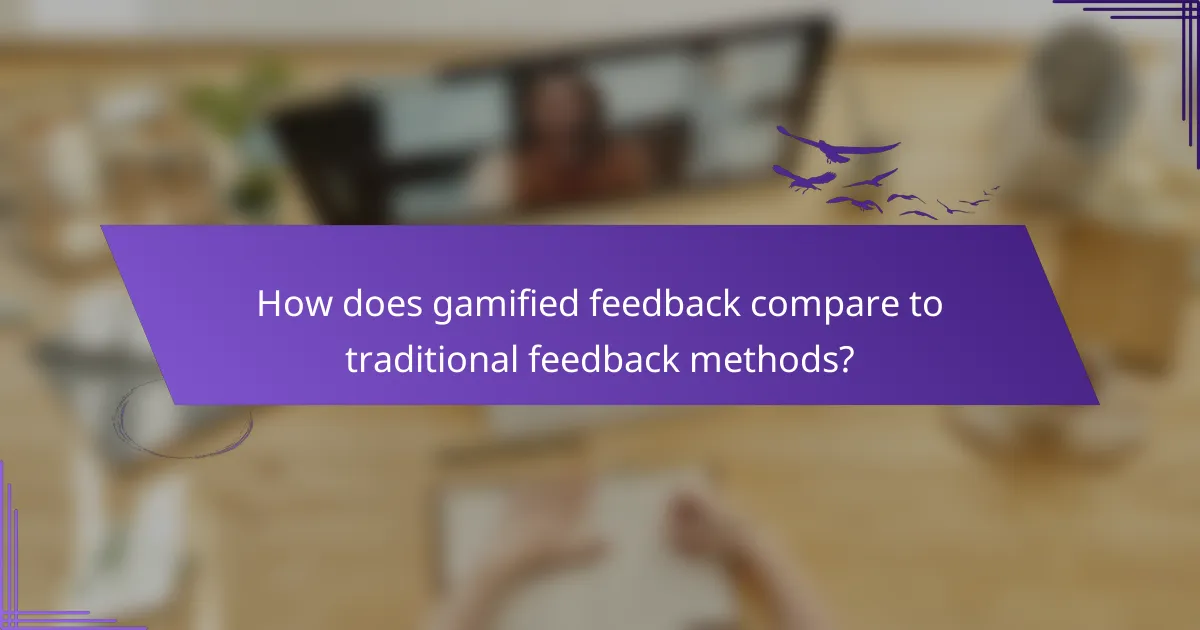
How does gamified feedback compare to traditional feedback methods?
Gamified feedback enhances the learning experience by incorporating game-like elements, making it more engaging than traditional feedback methods. While traditional feedback often relies on static assessments, gamified approaches provide dynamic, interactive experiences that motivate learners and foster deeper understanding.
Higher engagement rates
Gamified feedback significantly boosts engagement rates by transforming learning into an interactive experience. Learners are more likely to participate actively when they encounter challenges, rewards, and progress tracking, which are common in game mechanics. For instance, incorporating leaderboards or achievement badges can motivate students to complete tasks and improve their performance.
In contrast, traditional feedback methods often lead to passive learning, where students may feel detached from the material. By integrating gamification, educators can create a more stimulating environment that encourages continuous participation and enthusiasm.
More personalized learning experiences
Gamified feedback allows for more personalized learning experiences by adapting to individual learner needs. Through data tracking, educators can tailor challenges and rewards based on a student’s performance and preferences, ensuring that each learner receives feedback that resonates with them. This customization can lead to improved retention and understanding of the material.
Traditional feedback methods typically offer a one-size-fits-all approach, which may not address the unique learning styles of each student. By leveraging gamification, educators can create pathways that cater to diverse abilities, enhancing the overall educational experience.
Faster feedback cycles
Gamified feedback facilitates faster feedback cycles, allowing learners to receive immediate responses to their actions. This real-time feedback helps students identify areas for improvement quickly, enabling them to adjust their strategies and enhance their learning outcomes. For example, quizzes with instant scoring provide learners with immediate insights into their understanding.
In traditional settings, feedback can take days or weeks to be delivered, which can hinder progress and motivation. By implementing gamified systems, educators can streamline the feedback process, ensuring that learners remain engaged and informed throughout their educational journey.

What are the challenges of implementing gamified learning feedback?
Implementing gamified learning feedback presents several challenges, including resource allocation, training requirements, and ensuring that educational objectives are met alongside engagement. These obstacles can hinder the effectiveness of gamification in educational settings.
Resource allocation for technology
Effective gamified learning requires appropriate technology, which can be costly and resource-intensive. Schools and institutions must assess their budgets to determine if they can invest in necessary software, hardware, and ongoing maintenance.
Consideration should also be given to the accessibility of technology for all students. This may involve providing devices or ensuring that platforms are compatible with various operating systems and devices.
Training educators on gamification techniques
Educators need proper training to effectively implement gamified learning strategies. This training should cover both the technical aspects of the tools used and the pedagogical principles behind gamification.
Professional development programs can help teachers understand how to integrate game elements into their lessons while maintaining educational integrity. Collaboration among educators can also foster a supportive environment for sharing best practices and experiences.
Balancing fun with educational value
Finding the right balance between fun and educational value is crucial in gamified learning. While engaging elements can enhance motivation, they should not overshadow the learning objectives.
To achieve this balance, educators can set clear learning goals and regularly assess student progress. Feedback mechanisms should focus on both engagement and mastery of content, ensuring that students are learning effectively while enjoying the process.
